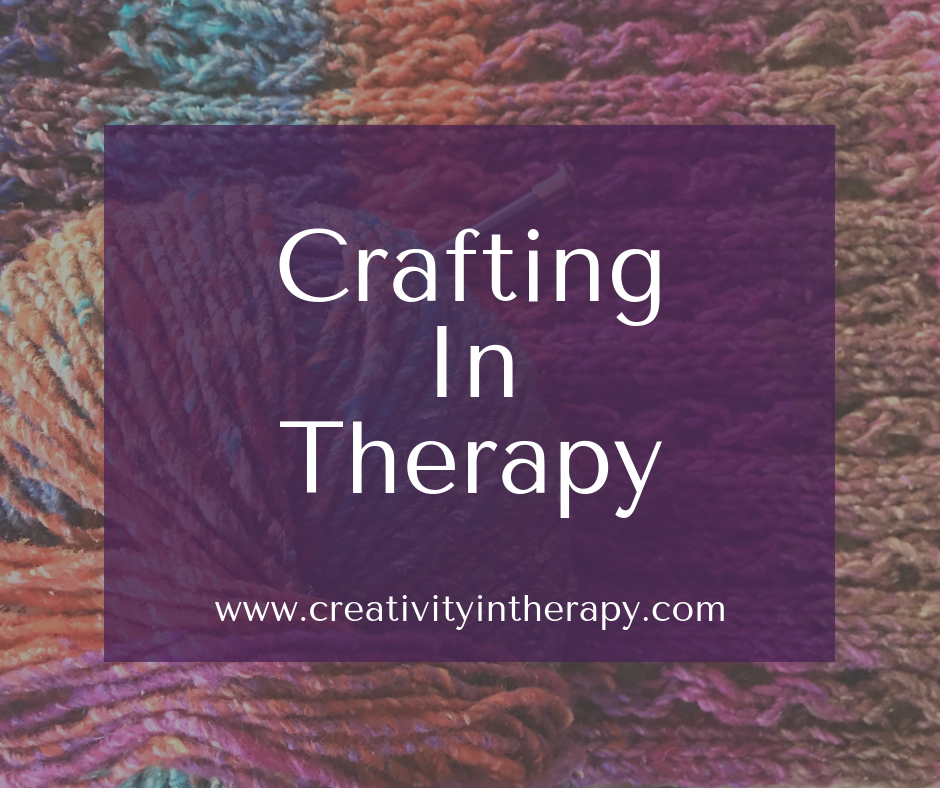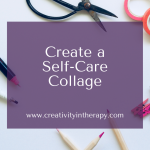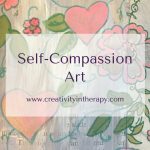
In the profession of Art Therapy, activities that are seen as “crafts” are often not given as much focus as the traditional fine arts, like painting, drawing, and sculpture. However, I believe there is value in offering crafting in our creative therapy approaches or in looking at the therapeutic value of clients doing crafts.
One of the important aspects of art therapy is the guidance of a well-trained art therapist – the therapist guides clients toward the art media and types of art-making that can be beneficial for them or to encourage them to have a new experience. When we thoughtfully consider what our clients are needing in the therapy room or what tools they need to be able to use at home, crafting is an option that can be helpful to include.
Why do we often exclude crafts from art therapy work and research?
When attending the AATA conference this year, I attended a few presentations that included crafting, primarily embroidery. One of the presenters, Lauren Leone, DAT, ATR-BC, LMHC, made the point that in many cultures there is little or no distinction between “crafts” and “fine arts.” They are all considered art, with no sense of one being better than the other. Lauren also points out that historically in Western cultures, many of the things we consider crafts are traditionally in the realm of women’s work and the fine arts were the realm of men. It is worth considering how this historical gender distinction may still color our perceptions, giving the traditional fine arts – painting, sculpture, drawing – more legitimacy than crafts…a perception that may have carried over as the profession of art therapy was developing.
Another barrier to the use of crafts in therapy is the idea that crafts do not typically allow for original self-expression. When we look more carefully at the various types of crafts and their benefits, however, we can see that personal and meaningful creativity is possible with crafts. We can also recognize that there are ways that a craft activity can be soothing and healing, even if there is little original expression.
With many crafting activities there are ways to do the activity that allow for originality and freedom of choice. Embroidery, for example, may follow a pattern, but the client is still able to make personal choices about what design they want to do, what colors to use, changes they may wish to make, etc. In addition, as someone gains confidence with a skill, they can go beyond the structured patterns and create more fully original works if they wish.
And, as mentioned, I believe that originality is not always necessary for something to be helpful. As illustrated in some of the points below, there are many ways that a craft may feel helpful to a client. Crafts, even the “unoriginal” kind that involve following instructions and a pattern, should be considered as part of the spectrum of art that we consider and make available for our clients.
Personally, crafting is something that I have always loved since I was a child. Throughout my life, my art-making has included traditional arts like painting, but also activities usually considered crafts like jewelry-making, origami, knitting, sewing, embroidery, and quilling. As an art therapy student and new art therapist, I didn’t really know if and how I could bring those activities in to therapy. Over the years, I have started to incorporate them more into my work as I became more attuned to what my clients needed, became more confident in making these decisions for myself, and learned through experiences working alongside non-art therapists and in some settings outside the traditional therapy office.
So, today I want to share a few thoughts about the benefits that I see in including crafts in therapy and when it may be helpful for our clients.
Having something to do with your hands while you talk. Much like the benefit of having fidgets available in the office, crafts can give the client something to do with their hands while they talk in session. This can be soothing, help to release anxiety that may come up, or give them something else to focus on when they need a break from the intensity of a discussion. Some people find it easier to concentrate on a discussion when they can fidget or doodle, so a craft activity can be one way to meet that need. Beading a necklace, knitting, crocheting, and embroidery are all craft activities that often involve repetitive action which does not take a lot of concentration, leaving the mind free to focus on conversation. (Art Therapist Deann Acton has some beautiful examples on her Instagram of embroidery that she does during session while her clients are also talking and embroidering.)
A sense of mastery, creativity, and achievement. Learning a new skill/activity or completing a craft project can help our clients to experience many of the same benefits as other art activities. Crafts can help them feel proud of learning something new or experience the sense of satisfaction that comes from creating something with their hands.
As a means to strengthen healthy coping skills. Think about all the skills that we may need to use when we work on a craft project – focus and concentration, organizing our steps, following directions, problem-solving, patience, frustration tolerance when it is challenging, not giving up, trying something new, and asking for help. If these are things that clients need to work on, crafting provides an experiential activity for doing so in therapy. In my practice, kids with poor focus, perfectionism, and low frustration tolerance often benefit from practicing new skills through craft activities.
Self-soothing and self-care tool. Crafts are something that clients can often do at home for self-care and self-soothing. And some crafts are more portable than many fine art activities – knitting, crochet, and embroidery can be taken with the client into many other settings outside the home where they may need a self-soothing activity. Although one option is that the therapist can simply suggest that a client try crafting at home and verbally encourage this, it may be helpful to actually experience the activity in session first. I have heard clients comment that they wouldn’t have tried something at home if they had not first had the opportunity to try it in session, really experienced the benefit, and had the support of the therapist. In addition, creating original art or art to express emotions may often feel stressful and challenging to clients, so there may be times that we want to offer an activity that serves the purpose of calming and regulating emotions.
A more accessible art form. Many of our clients may struggle with feeling like they are not artistic or be intimidated by activities like painting. However, trying crafting as a creative activity may feel more accessible to them or be something that they are already comfortable with. If we think about the importance of meeting our clients where they are, we may want to recognize that this may include starting art therapy with a crafting activity that they already have some confidence in trying. For some clients, this may help them be able to engage in art in some way and then later be able to explore new media and approaches to art.
Bilateral stimulation and brain integration. More and more research is highlighting the benefits of activities that involve bilateral stimulation. Using both hands in an activity or doing something that involves alternating right-left sides of the body may be helpful in promoting brain integration. In addition to activities like drumming, yoga, dance, and running, crafts like knitting and crochet may help to provide this bilateral stimulation. (See this article by Lisa Danylchuck on Good Therapy for more information from an EMDR therapist’s perspective.) Crafts will not replace a treatment protocol like EMDR, but may still be a helpful thing to encourage for mental health.
Want to try to support crafting more for your clients? Here are a few of the things that I have available in my office for kids, teens, and adults in therapy:
- Origami and other paper crafts
- Beading for creating jewelry or meditation beads
- Fuse beads/ Perler beads
- Sewing
- Embroidery
- Knitting and crochet
What are your thoughts on crafts in therapy? Is it something that you include in your creative approaches? If you are an art therapist, what attitudes have you encountered in the profession regarding crafts versus fine art forms?
Carolyn Mehlomakulu, LMFT-S, ATR-BC is an art therapist in Austin, Texas who works with children, teens, and families. For more information about individual therapy, child and teen counseling, family therapy, teen group therapy, and art therapy services, please visit: www.therapywithcarolyn.com.
This blog is not intended to diagnose or treat any mental health conditions. All directives, interventions, and ideas should be used by qualified individuals within the appropriate bounds of their education, training, and scope of practice. Information presented in this blog does not replace professional training in child and family therapy, art therapy, or play therapy. Art therapy requires a trained art therapist.
* This blog may include affiliate links (see full disclosure here). If you’d like to help support the blog without any extra cost to you, please click through on links and shop as you normally would. Your support is greatly appreciated!





I will often have clients create friendship bracelets. These are simple to create but provide a sense of accomplishment for the client. I also do simple beading projects such as animal key rings. Both of these activities require using both hands and thus tapping into bilateral stimulation and brain integration.
As an Art Therapist for some 40+ years, I have regularly incorporated crafts, but always with an intentional understanding of media, process, process metaphors, and making these explicit as appropriate with individual clients and groups.
Yes, being intentional about the media and process are so important!
Can you please explain to me what it means to be intentional/ intentional understanding? Specifically around media and processes?
Hi Michelle. Being intentional around media and process in art therapy would refer to being thoughtful and choosing things for a specific reason, not just randomly choosing a craft or giving every client the same directive. For example, I may suggest to a child that we could make beaded bracelets when I notice that they are having trouble opening up. I am intentionally suggesting something that (1) feels easy and safe to them, (2) allows us to keep talking as we work while also giving them something else to put their attention on, and (3) gives them a transitional object to take home. However, if a child came in and was talkative and upset about something that had happened in their week, it would be more helpful to guide them toward a different type of art media and process.
I had my client making earrings in the session and she loved that she could design her own earrings. She is always resistant to express herself or would have emotional breakdown when she writes or talks. But in that session, I got to see her feel relaxed and hopeful talking about her interest in various arts and her dream in being a professional dancer! And she felt better about herself when she realized her talents and potentials. Yes talking through making things/ crafting is really helpful in lowering the anxiety level of the client.
What a great example of crafting being therapeutic in session! Thanks for sharing.
Crafting during the holidays in an inpatient facility is very helpful i.e soothing and provides a tangible piece as a gift to self or others during this difficult time. I have also set up my sewing machine in my art space for the active duty patients-great conversations about grandparents who sewed and learning to repair combat fatigues during bootcamp.
Yes! For some populations like inpatient, residential treatment, or foster care, it can be a great opportunity to make gifts for others. That’s so awesome that you’re able to set up a sewing machine in your art space.
how can i get involve with this program
Hello – which program are you referring to?
Hi! I always loved this idea. I wished my therapist would have done something this when I was in therapy. Now, I have joined an online group. Our leader will suggest drawing with journaling. I do a lot of arts & crafts on my own… drawing, crocheting, painting, paper crafting, or sewing. It’s amazing how it can soothe. I even do arts & crafts with my friends and their kiddos. It’s fun & engaging.